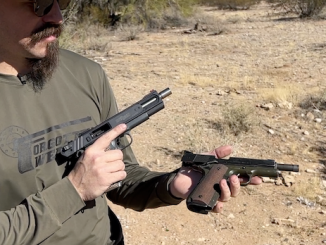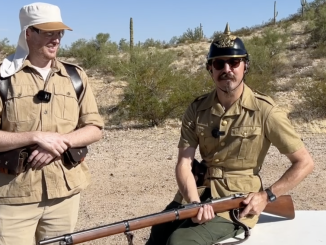I recently picked up a very nice looking Gewehr 88 from an online classified ad, and when it arrived I really didn’t know what I had (I’m not an expert on older German bolt actions by any stretch of the imagination). So, I poked through our reference library for a suitable looking work to explain where this rifle had been for the last 122 years (it is an 1890 dated Loewe receiver). Paul Scarlata’s book really did the trick – other than being able to read the Turkish rear sight gradations, I now know what pretty much every stamp on the gun means.Plus a good knowledge of the development and manufacturing history of the piece!
Do you have a Gewehr 88 that you need to learn more about? Or do you want to educate yourself so you can tell exactly what you’re looking at next time you find one at a gun show? You should get a copy of the book yourself:




Hey Ian, I found some 8mm round nosed online. It’s rather pricy and it comes in the en blocs, but if you’re wanting to shoot round nosed you can.
https://www.libertytreecollectors.com/productcart/pc/viewPrd.asp?idproduct=1637&idcategory=12
Slug your Bore. My Kar-88 and Gew-88 both slug out to .322. I have had luck with Hornady .323 150grain Spitzers and 40 grains of IMR 4064. Congrats on joining the Commission Club! They are fine shooters!
I have one that has been remanufactured by the Turks at Ankara in 1934. They did away with the barrel jacket as well as the en bloc clip, they altered the rifle to feed from a magazine using an interupter. Mine is slugged at .323, ultra smooth actions..
I have a Gew 88 made in Spandua 1890 with no receiver modifications but a Turkish bolt. I have never shot this rifle or slugged it, should I assume it is still chambered for the 8x57J .318″ bullet? I also have a Turkish model with no barrel jacket, magazine modifications and brazed on stripper guides. I have shot the Turkish 88 with .318 cast bullets but perhaps that was not necessary due to signs of later modifications. When these rifles were reworked did they just ream the bore to accommodate for the larger .323 dia. bullet?
It is a myth that the bore was enlarged. When the .323 S bullet was introduced, the Gewehr 98 had (and kept) the same land-to-land and groove-to-groove diameter as the Gewehr 88 of late productions. (Early G88 had a groove depth of 0.1 mm which was deepened to 0.15 mm LONG before introduction of the S bullet.)
The only difference was in the bullet diameter. The original round nose bullet (Patrone 88) set up considerably to fill the bore. To ensure the same for the S bullet, it had to be given the larger .323 diameter. As a consequence, the case neck and the chamber in the neck area had to be increased. Only the neck was changed, not, repeat not, the bore dimensions.
This was more or less copied from the French, who had given their balle D a larger diameter than the previous balle M.
The 8×57 I cartridge the name is from a much later period) is a creation of the German civilian gun trade. Gewehr 88 are CIP proofed for it because of the neck diameter in the chamber, not the land and groove diameter.
Scarlata’s book covers the bore issue quite well, FYI.
Ancient Mausers are not near the center of my expertise, but foreign languages are. If all you want to do is translate the Ottoman Turkish numbers to “arabic” numerals as we who use Roman scripts (including post-1928 nationalist Turks) do, any reference to Arabic (the language) numerals works, because the written numbers are the same in Arabic, Turkic, and Persian languages. The words for the numbers are different, but that shouldn’t matter much if all you want is the English meaning of these numerals.
These Middle Eastern/Central Asian languages are written right to left, but the numbers are written left to right same as ours. It can be quite amusing to watch the eyes of an Afghan or Turk reading a report with a lot of figures in it — a little disorienting to the westerner.
Also, beware dates. Several different calendars and date systems are used in this region, including regular Gregorian/AD (CE if you’re PC), Hegira-based lunar calendars, etc. The Ottomans used (IIRC) a lunar calendar until about 1830, then used the very strange Rumi calendar, which is a Julian solar calendar (as used at the same time by Russia), but with date numbering beginning with the Hegira, so years are the Julian year minus 584 (what? not 622? That’s because on the old calendar they’d been dropping one year of every 33 to correct for the different length of solar and lunar years). If this calendar were still operative, then, this year would be 1428. Your Mauser was made in 1306 or so…
Generally, the Ottoman bureaucracy and army was leaning forward towards the west long before the populace (indeed, lots of the countryside still leans back as much as they can). So you might find uses of western dates on Turkish guns — I don’t know enough about them to say, but it wouldn’t surprise me.
I have no idea how I missed this book. I have Scarlata’s Bolt Action Rifle and Mannlicher books. Guess I’ll be getting this one, too…
(…and, FWIW, my Danzig-made 88/05 is also dated 1890. 🙂 )
Nice! I’ll be taking mine out next week with an 1886/93 Lebel for a little comparison and shoot-off.
I need to get a Lebel. Seems like you never see them around anymore in the wild.
My WWI French rifles are both Berthiers…
There are just way too many French rifle variants out there that one really needs to have for a good collection. Every time is looked like war with Germany (so, a lot) they refurbed everything in the arsenals to a new standard. Carbines, 3-round mags, 5-round mags, 8mm Lebel, 7.5×54, it just keeps going. The one we really want to add to the collection here is a 1918 St Etienne semiauto.
I vote for the 1917 or 1918 St. Etienne. Even the 1918 carbine would be nice.
Just a word of warning, the Mannlicher Military Rifles and Gew 88 Commission Rifle books both share about 1/4 their content. Necessary overlap due to the incestuous nature of weapons design and relevance, but a little disappointing if you buy both and then realize they’re Ctrl+C Ctrl+V for the last quarter.